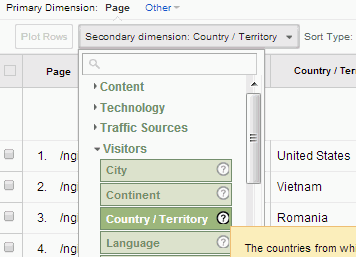Understanding Secondary Dimension in Google Analytics: A Full Overview
Understanding Secondary Dimension in Google Analytics: A Full Overview
Blog Article
Transform Your Analytics Technique With Secondary Dimension in Google Analytics
By incorporating additional dimensions right into data evaluation, a new layer of understandings arises, dropping light on intricate user actions and interactions. The critical application of additional measurements holds the key to opening a treasure trove of important information that can change how organizations translate and act upon their data.
Comprehending Second Dimensions in Google Analytics
Secondary dimensions in Google Analytics give additional context to main information by allowing individuals to assess metrics across a second dimension, supplying deeper insights into customer actions and interactions on a web site. Secondary Dimension in Google Analytics. While primary dimensions supply fundamental information factors such as pageviews, bounce rate, and session period, second dimensions supply a more comprehensive sight by segmenting the key information further. This segmentation enables customers to examine metrics in mix with another dimension, such as traffic sources, demographics, or individual habits
Advantages of Making Use Of Second Measurements
Utilizing additional measurements in Google Analytics uses a strategic advantage by enhancing the depth of analysis and offering a much more detailed understanding of customer communications and actions on an internet site. By incorporating secondary dimensions, analysts can acquire useful insights into the performance of specific segments or variables within their information. This makes it possible for an extra thorough examination of customer actions past surface-level metrics, enabling a deeper exploration of the factors affecting customer interaction and conversions.

How to Apply Additional Measurements
When integrating second dimensions in Google Analytics, one necessary step is to choose the pertinent metrics and dimensions to improve the analysis process. Clicking on this button will certainly open up a drop-down food selection listing various measurements that can be included to your key dimension for much deeper understandings.
After selecting the proper second dimension, such as 'Source/Medium' or 'Gadget Classification,' Google Analytics will certainly present the data in a much more detailed style, enabling you to cross-analyze various facets of customer behavior. Remember to try out different combinations of key and secondary dimensions to discover useful patterns and patterns that can notify your advertising and marketing strategies. By executing additional measurements attentively, you can obtain a more comprehensive understanding of your website or app efficiency and make data-driven choices to maximize your electronic existence.
Analyzing Data With Second Dimensions
Improve your data evaluation in Google Analytics by incorporating second dimensions to delve much deeper right into individual behavior patterns and optimize your electronic advertising strategies properly - Secondary Dimension in Google Analytics. By including second dimensions to your primary information, you can acquire valuable understandings that can help you make educated decisions concerning your web site or app performance
Examining data with second dimensions permits you to section your key information better, supplying a much more thorough view of customer interactions. For example, incorporating the main measurement of 'source/medium' with an additional measurement like 'landing page' can disclose which particular web pages are driving traffic from various resources. This details can be important in improving your web content method or maximizing your marketing campaign to increase conversions.
Moreover, making use of secondary dimensions allows you to recognize connections in between various metrics, helping you understand the impact of different variables on user behavior. Whether it's examining demographics along with customer involvement metrics or device categories with conversion rates, additional dimensions equip you to reveal surprise trends and patterns that can guide your marketing efforts.
Enhancing Performance With Second Dimensions
To enhance the performance of information evaluation and decision-making in Google Analytics, including secondary measurements is key to optimizing performance metrics and getting much deeper understandings right into customer here are the findings actions patterns. By making use of second measurements, experts can dig beyond surface-level data and uncover valuable correlations that might or else go undetected. This optimization method allows services to tailor their advertising efforts more effectively, recognize locations for click to investigate enhancement in web site functionality, and enhance overall customer experience.
Additional dimensions offer an even more thorough sight of individual interactions by giving added context to main data metrics. Coupling the primary measurement of 'landing web page' with an additional measurement like 'gadget category' can expose whether certain tools are much more most likely to drive involvement on specific touchdown pages. This understanding can inform responsive layout enhancements or targeted advertising methods to boost efficiency.

Conclusion
To conclude, the combination of second measurements in Google Analytics offers businesses with an effective tool to boost their analytics method. Secondary Dimension in Google Analytics. By delving deeper right into user actions and communications, marketers can discover valuable understandings that can drive performance optimization and boost the overall individual experience. Leveraging secondary dimensions enables a much more comprehensive evaluation of data, causing even more educated decision-making and customized advertising initiatives
Secondary measurements in Google Analytics provide extra context to key information by enabling customers to evaluate metrics throughout a second dimension, supplying deeper insights right into user behavior and communications on a web site. While primary dimensions supply basic data points such as pageviews, Read Full Report bounce price, and session period, secondary dimensions use an even more detailed view by segmenting the main data further.One of the crucial advantages of making use of secondary dimensions is the capability to reveal relationships and patterns that may not be promptly noticeable when analyzing data with main measurements alone.When including secondary dimensions in Google Analytics, one vital action is to choose the pertinent metrics and measurements to improve the evaluation procedure. Pairing the primary dimension of 'landing web page' with a secondary measurement like 'tool group' can reveal whether certain devices are more likely to drive engagement on particular landing pages.
Report this page